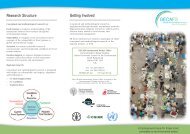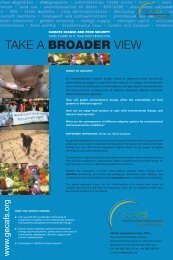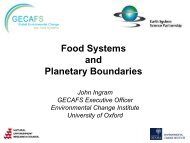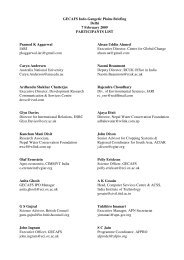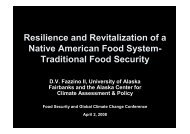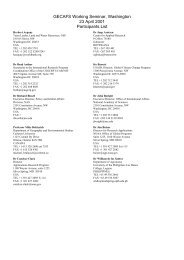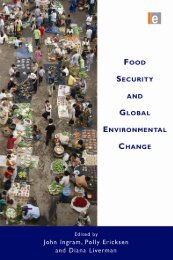From Food Production to Food Security - Global Environmental ...
From Food Production to Food Security - Global Environmental ...
From Food Production to Food Security - Global Environmental ...
- No tags were found...
You also want an ePaper? Increase the reach of your titles
YUMPU automatically turns print PDFs into web optimized ePapers that Google loves.
Box 1 <strong>Food</strong> system Activities and food security Outcomes (Ericksen, 2008a; Ingram, 2009;Ericksen et al., 2010a)<strong>Food</strong> systems encompass a number of Activities which give rise <strong>to</strong> a number of food securityOutcomes.<strong>Food</strong> systems Activities include: (i) producing food; (ii) processing food; (iii) packaging anddistributing food; and (iv) retailing and consuming food. All these activities are determined by anumber of fac<strong>to</strong>rs (‘determinants’). The determinants of ‘packaging and distributing’ food, forinstance, include the desired appearance of the final product and other demands of the retailer,the shelf life needed, cold chain and/or other transportation infrastructure, road, rail and shippinginfrastructure, trade regulations, s<strong>to</strong>rage facilities, etc. (Figure 1).Undertaking these activities leads <strong>to</strong> a number of Outcomes, which not only contribute <strong>to</strong> foodsecurity, but also relate <strong>to</strong> environmental and other social welfare issues (Figure 1).<strong>Food</strong> security outcomes are grouped in<strong>to</strong> three components (Availability, Access andUtilisation), each of which comprises three elements (Figure 1). All nine elements are eitherexplicit or implicit in the FAO definition above (FAO, 1996b); all have <strong>to</strong> be satisfied and stableover time for food security <strong>to</strong> be met.Both the activities and their outcomes are influenced by the interacting GEC and socioeconomic‘drivers’; and the environmental, food security and other social outcomes of the activitiesfeedback <strong>to</strong> the drivers (Figure 2).While enhancing food security may often be the prime motive when planning adaptationstrategies for the additional stresses GEC is bringing, Figure 1 shows that the food systemactivities also give rise <strong>to</strong> other outcomes. These relate <strong>to</strong> other socioeconomic issues andconditions, and <strong>to</strong> the environment, and all have feedbacks <strong>to</strong> the food system drivers (Figure2); while many fac<strong>to</strong>rs not directly related <strong>to</strong> the food system (e.g. fossil fuel use generally,urbanisation) drive GEC, land-use change, intensified agricultural practices, overexploitationof fisheries, food processing and transport, etc. are all major drivers of GEC (see Example 4,below). What might be ‘good’ adaptation for food security might also be good for othersocioeconomic and/or environmental outcomes – but it might also be worse; synergies andtrade-offs need <strong>to</strong> be carefully considered, although the complexity of the food system makesanalyses difficult. However, the current evidence of food insecurity and environmentaldegradation suggests that mal-adaptation may already be occurring (Ericksen et al., 2010b).The key questions are (i) which activity(s) should we best seek <strong>to</strong> adapt <strong>to</strong> improve foodsecurity for given situations; (ii) what will be the consequences of such adaptation strategiesfor the full set of food security elements; and (iii) what will be the synergies and trade-offsamong the three food system outcomes and the feedbacks <strong>to</strong> food system drivers? Beinghighly aggregated the food system framework (Figure 2) cannot answer these questions perse, but it is useful for generating hypotheses that can be further explored using other morespecific methods.40



